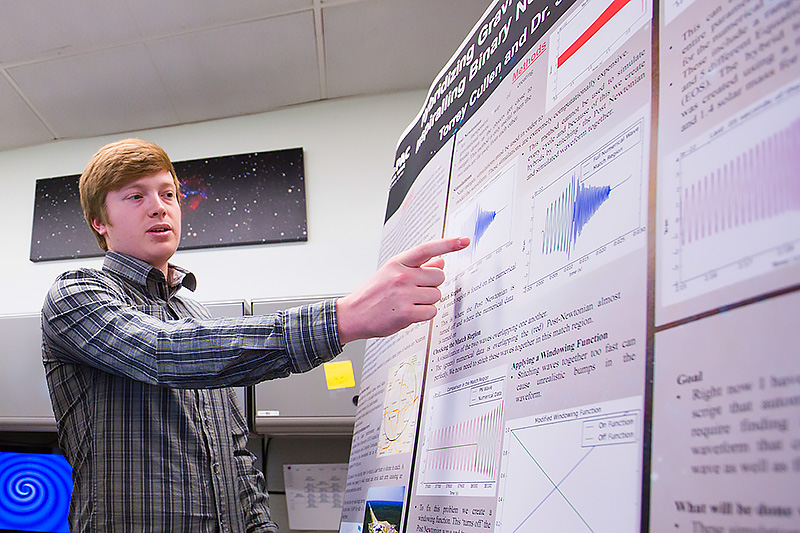CSUF News Service
Physics Alumnus Gets a Stellar Sign

CSUF alumnus Torrey Cullen is among student contributors to the first detection of gravitational waves produced by colliding neutron stars. Cullen is now a doctoral student at Louisiana State University, studying gravitational-wave astronomy.
Oct. 16, 2017
It was a Friday afternoon presentation about black holes and gravitational-wave science at Cal State Fullerton's Gravitational-Wave Physics and Astronomy Center that got Torrey Cullen, then an undergraduate, hooked on astrophysics.
Cullen, who earned his bachelor's degree in physics last year, was mentored by CSUF binary neutron star expert Jocelyn Read, whose groundbreaking astrophysical research contributed to the first detection of gravitational waves produced by colliding neutron stars.
Now a first-year doctoral student in Louisiana State University's physics program, he has continued to work with Read and is among student contributors to this new detection of gravitational waves, announced today (Oct. 16). The discovery was made by using the U.S.-based Laser Interferometer Gravitational-Wave Observatory (LIGO) and the Europe-based Virgo detector.
Cullen and Read, assistant professor of physics, helped interpret the first detection of gravitational waves from the neutron star merger. Cullen is a co-author and Read is a lead writer of the neutron star discovery paper, published today in Physical Review Letters. He also is lead author on a submitted journal article, "Matter Effects on LIGO/Virgo Searches for Gravitational Waves From Merging Neutron Stars,” with Read and CSUF undergraduate Eric Flynn co-authors.
The CSUF alumnus is even more excited about his research and the future of gravitational-wave astronomy and what this detection means to better understand the workings of the universe.
"The most exciting thing here is what was discovered," Cullen said. "It’s awesome to see this rare cosmic event — something you’ve spent so much time on hoping to see."
Cullen's research focuses on modeling waveforms to help detect gravitational waves from different sources like neutron stars.
"The best example of this is working with tidal effects," he explained. "The same way the Earth and the moon affect each other tidally, when two neutron stars are orbiting each other, they stretch and squeeze one another.
"My work investigates to see how dramatically the waveform models change, with the overall goal of helping LIGO identify detected waveforms more accurately."
Working on the pioneering research alongside Read and other physicists at the Gravitational-Wave Physics and Astronomy Center prepared Cullen for advanced studies in the emerging field of gravitational-wave astronomy.
"Having mentors like Dr. Read and other CSUF professors gave me an invaluable edge when applying to graduate schools," he said. "The experience also provided me the opportunity to learn about a career as a professor and a researcher — and made me realize that’s something I wanted to pursue."
